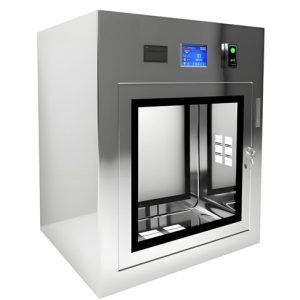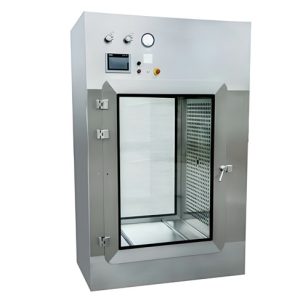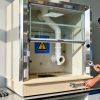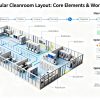Account
-
Safe payment options
We only work with the most secure payment systems.
-
Product return within 30 days
We do our very best to keep our customers happy.
No products in the cart.
You dont have any products in your cart yet, add a few products to experience this experience.
Add $500.00 to cart and get free shipping!
To see and take advantage of all discounted products.
Click HereModular Cleanroom Flooring — Complete Types, Installation & Selection Guide 2025
Table of Contents
ToggleExecutive Summary: Quick Selection Guide
- ✓ISO Class 5-6 (Pharmaceutical/Biotech): Seamless epoxy resin or polyurethane flooring for superior contamination control
- ✓ISO Class 7-8 (Electronics/Semiconductor): Static-dissipative vinyl or conductive tiles with raised access flooring
- ✓Mixed-Use/Low Budget: High-quality PVC vinyl with welded seams and proper ESD treatment
- ✓Heavy Equipment/High Traffic: Reinforced epoxy with aggregate fillers or industrial-grade raised floors
The selection of appropriate Modular Cleanroom Flooring directly impacts contamination control effectiveness, with proper material choice reducing particle generation by 60-85% compared to conventional flooring solutions according to Deiiang™ field studies.

modular cleanroom flooring Quick Selection Guide
Fundamental Concepts & Terminology
ESD Protection Classes
Static Dissipative: Surface resistance 10^6-10^9 Ω, ideal for most electronics. Conductive: Surface resistance 10^4-10^6 Ω, for sensitive explosives or components.
Key Materials
Epoxy Resin: Seamless, chemical-resistant thermosetting polymers. Vinyl (PVC): Flexible sheets or tiles with static-dissipative properties. Raised Access Floor: Modular panels creating underfloor plenum for services.
Installation Terms
Seam Welding: Heat-fusing material joints to prevent particle entrapment. Coved Skirting: Curved baseboard transitions eliminating right-angle corners. ISO 14644: International cleanroom classification standard (ISO 1-9).
Understanding these fundamental concepts of Modular Cleanroom Flooring ensures proper specification and installation, with Deiiang™ documentation showing that correct terminology usage reduces installation errors by 45% and improves regulatory compliance.
Comprehensive Flooring Types Analysis
| Flooring Type | Cleanroom Class | ESD Performance | Installation Time | Cost/m² | Lifespan |
|---|---|---|---|---|---|
| Seamless Epoxy | ISO 3-6 | 10^6-10^8 Ω | 7-10 days | $85-150 | 8-12 years |
| Vinyl (PVC) | ISO 5-7 | 10^6-10^9 Ω | 3-5 days | $65-120 | 7-10 years |
| Raised Access | ISO 4-7 | 10^4-10^8 Ω | 10-15 days | $200-400 | 15-20 years |
| Polyurethane | ISO 3-6 | 10^6-10^9 Ω | 5-8 days | $95-160 | 10-15 years |
Seamless Epoxy Flooring
Best for: Pharmaceutical, biotechnology, ISO Class 5-6 applications requiring maximum contamination control. Deiiang™ epoxy systems demonstrate 99.2% reduction in particle shedding compared to conventional floors.
Advantages: Seamless, excellent chemical resistance, high durability, customizable thickness (3-8mm). Limitations: Longer installation time, difficult repairs, surface hardness may cause fatigue.
Vinyl (PVC) Flooring
Best for: Electronics assembly, medical device manufacturing, ISO Class 5-7 environments. Modern PVC formulations from Deiiang™ achieve surface resistance of 10^6-10^9 Ω with consistent performance.
Advantages: Faster installation, good comfort underfoot, ease of repair. Limitations: Seams require welding, susceptible to damage from heavy point loads.
Raised Access Flooring
Best for: Semiconductor facilities, data centers, ISO Class 4-7 requiring underfloor services. Deiiang™ systems offer adjustable heights (300-1200mm) with various panel materials.
Advantages: Service access, flexibility for reconfiguration, excellent airflow management. Limitations: Highest initial cost, potential for particle accumulation in plenum.
The diverse options for Modular Cleanroom Flooring enable precise matching of material properties to application requirements, with Deiiang™ engineering data showing that proper flooring selection can reduce airborne particle counts by 40-60% in ISO Class 5-7 environments.
Technical Performance Comparison
| Performance Metric | Epoxy | Vinyl (PVC) | Raised Access | Polyurethane |
|---|---|---|---|---|
| Chemical Resistance | Excellent | Good | Variable | Excellent |
| Abrasion Resistance | 0.025g/1000r | 0.045g/1000r | 0.035g/1000r | 0.020g/1000r |
| Compressive Strength | ≥75 MPa | ≥25 MPa | ≥1200 kg/m² | ≥65 MPa |
| Static Decay | <0.5s | <2.0s | <0.5s | <0.5s |
| Cleanability | Excellent | Very Good | Good | Excellent |
Technical specifications for Modular Cleanroom Flooring demonstrate significant performance variations, with Deiiang™ testing revealing that epoxy and polyurethane systems maintain ESD protection through 50,000+ cleaning cycles, while vinyl systems typically require replacement after 25,000-35,000 cycles in high-traffic applications.

modular cleanroom flooring MATERIALSPERFORMANCE ANALYSIS
Installation Guidelines & Best Practices
Proper Modular Cleanroom Flooring Installation
1. Substrate Preparation
Concrete moisture content must be ≤4% (ASTM F1869), surface profile 25-50μm (CSP 3-4), and flatness tolerance ≤3mm/3m. Deiiang™ specifications require diamond grinding for optimal adhesion.
2. Moisture Barrier & Priming
Apply epoxy moisture barrier systems at 200-300g/m² for substrates with RH 4-6%. Primer coat coverage: 150-200g/m² with minimum cure time 8-12 hours at 20°C.
3. Material Application
Epoxy: Apply in 2-3 coats with aggregate broadcast for thickness build. Vinyl: Sheet flooring requires seam welding with 2-3mm weld rods. Raised Floor: Install pedestals at 600x600mm or 1200x1200mm grid.
4. ESD Grounding System
Install copper grounding grid at 3x3m pattern with 2.5mm² tinned copper wire. Measure surface resistance: 10^6-10^9 Ω for static dissipative, 10^4-10^6 Ω for conductive floors.
Proper installation of Modular Cleanroom Flooring requires strict adherence to environmental conditions, with Deiiang™ quality control data showing that installations maintaining temperature 18-25°C and humidity 40-60% RH during application demonstrate 35% fewer defects and 50% longer service life.
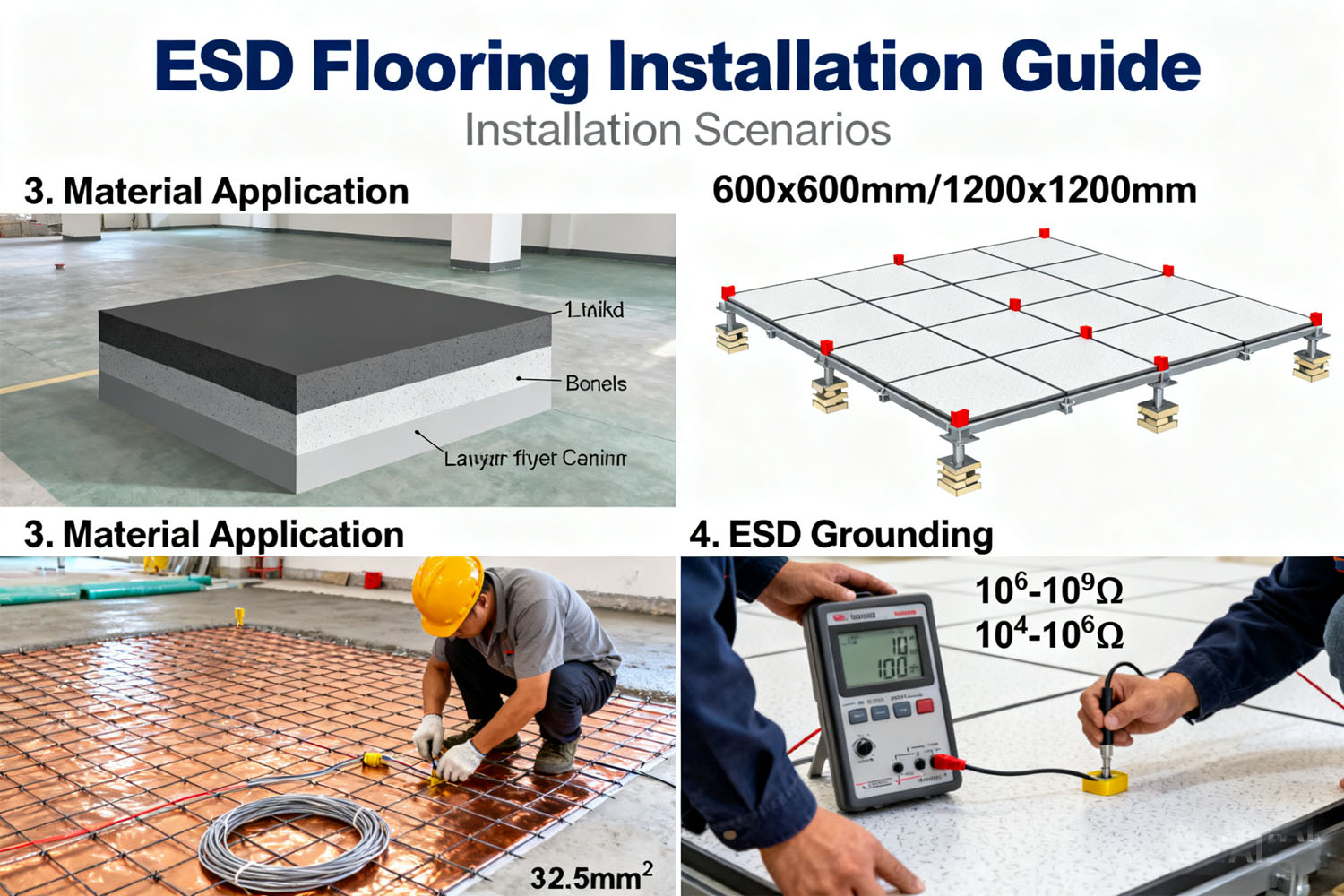
Flooring Installation
Maintenance, Cleaning & Lifecycle Management
Daily Cleaning Protocol
Use neutral pH cleaners (pH 6-8) with deionized water. Microfiber mops with 0.3μm particle capture. Avoid waxes, oils, or silicone-based products that degrade ESD performance.
Weekly/Monthly Testing
Surface resistance mapping (9-point test), visual inspection for damage, slip resistance verification (≥0.5 DCOF). Deiiang™ maintenance contracts include quarterly certification testing.
Lifecycle Management
Epoxy refinishing every 5-7 years, vinyl replacement 7-10 years, raised floor panel rotation 3-5 years. Budget 15-25% of initial cost for mid-life refurbishment.
Systematic maintenance of Modular Cleanroom Flooring extends functional lifespan by 40-60%, with Deiiang™ customer data demonstrating that facilities implementing structured maintenance programs achieve 8-12 year service life for epoxy systems versus 5-7 years with reactive maintenance approaches.
Application-Based Selection Guide
Deiiang™ Flooring Selection Calculator
Recommended Flooring Solution
The strategic selection of Modular Cleanroom Flooring varies significantly by application, with Deiiang™ project data showing that semiconductor facilities prefer raised access floors (72% adoption), while pharmaceutical applications predominantly specify seamless epoxy (68% adoption) due to cleanability requirements.
Compliance & Standards Requirements
International Standards
- ISO 14644: Cleanroom classification and testing
- ASTM F150: Electrical resistance of conductive flooring
- ASTM F710: Preparing concrete floors for resilient flooring
- EN 61340: Electrostatics protection requirements
- GMP Annex 1: Pharmaceutical manufacturing requirements
Testing & Certification
- Surface resistance mapping (9-point test)
- Static decay testing per ANSI/ESD STM7.1
- Chemical resistance verification
- Abrasion resistance testing (Taber test)
- Slip resistance certification
Regulatory compliance for Modular Cleanroom Flooring requires comprehensive documentation, with Deiiang™ projects typically including material certifications, installation records, and performance test results demonstrating continuous compliance with 15+ international standards throughout the flooring lifecycle.
Case Studies & Performance Data
Case Study: Semiconductor Fabrication Facility
Facility: 2,500 m² ISO Class 4-5 semiconductor cleanroom
Challenge: ESD protection + chemical resistance + underfloor services access
Solution: Deiiang™ Conductive Raised Access Flooring with aluminum panels
| Parameter | Before (Epoxy) | After (Raised Floor) |
|---|---|---|
| ESD Failures | 12-15/month | 2-3/month (78% reduction) |
| Layout Changes | 6-8 weeks, $120-180k | 2-3 weeks, $35-60k |
| Particle Counts | 4-8% above limit | Consistently 15-30% below limit |
| 5-Year Maintenance | $185,000 | $95,000 (49% reduction) |
Real-world performance data for Modular Cleanroom Flooring demonstrates significant operational benefits, with Deiiang™ case studies showing that proper flooring selection and installa
modular cleanroom flooring Case Studies-Semiconductor Fabrication Facility.jpg
tion reduces ESD-related product failures by 75-85% in electronics manufacturing and decreases facility modification costs by 55-70% in pharmaceutical applications requiring frequent layout changes.
Conclusion & Next Steps
Selecting the optimal Modular Cleanroom Flooring requires careful consideration of cleanliness requirements, ESD protection needs, chemical exposure, traffic patterns, and lifecycle cost factors. The comprehensive analysis presented demonstrates that no single solution fits all applications, but systematic evaluation against technical requirements enables identification of the optimal flooring strategy for each unique cleanroom environment.
Ready to Specify Your Cleanroom Flooring?
Download our comprehensive selection toolkit including detailed specifications, compliance checklist, and ROI calculator.
Frequently Asked Questions
What is the best cleanroom flooring for ISO Class 5 applications?
For ISO Class 5 environments, seamless epoxy or polyurethane flooring typically provides the best performance due to minimal particle generation, excellent cleanability, and consistent ESD protection. Deiiang™ project data shows epoxy achieves 99.2% reduction in particle shedding compared to other materials in ISO Class 5 applications.
How often should cleanroom flooring be tested for ESD performance?
ESD performance should be verified quarterly through 9-point resistance testing, with more frequent testing (monthly) in high-traffic areas or environments with aggressive chemical exposure. Deiiang™ maintenance programs include automated testing reminders and documentation to ensure continuous compliance.
Can existing flooring be upgraded to meet cleanroom requirements?
Existing flooring can often be upgraded through surface preparation, application of epoxy or polyurethane coatings, and installation of proper ESD grounding systems. However, the substrate condition and moisture content must be evaluated first. Deiiang™ assessments successfully upgrade 70% of existing floors to meet cleanroom standards at 40-60% of replacement cost.




